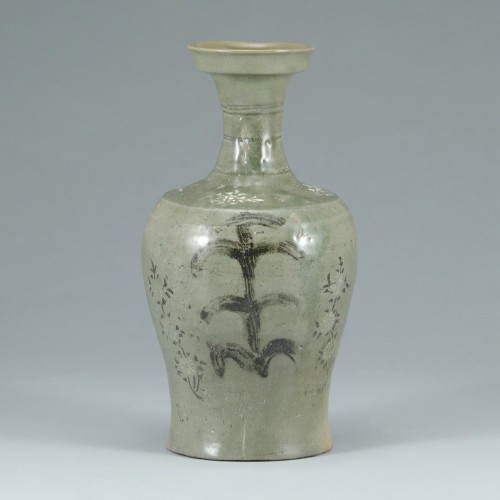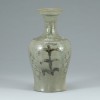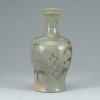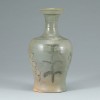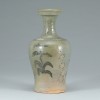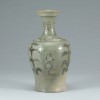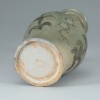본문
청자철화초화문광구병은 넓게 벌어진 구연부와 잘록한 목, 풍만한 어깨에서 하단으로 갈수록 좁아지다가 다시 살짝 벌어지는 형태로, 안정감 있는 비례와 유려한 선형미가 조화를 이루고 있습니다.
굽은 안정적인 안굽으로 마감되었고, 바닥의 무유면은 태토의 질감이 그대로 드러나 소성 조건과 제작 기술을 추정할 수 있는 부분입니다.
어깨 부분의 모란문은 백상감으로, 중앙의 국화문은 흑백상감으로 시문하였습니다. 유약은 투명한 비색을 띠며, 그 아래 철화 안료로 시문된 초화문은 자유로운 필선과 회화적 구성을 통해 미감이 드러납니다. 초화문은 풀과 꽃을 주제로 하여 자연의 생명력과 정서를 상징하고, 당대 문인과 상류층의 심미 의식을 반영합니다.
철화 기법은 철분 안료로 문양을 표현하고 고온에서 소성하는 방식으로, 갈색부터 암갈색까지 다양한 농담을 연출합니다. 청자 상감문과 구별되는 회화적 장식성을 지닌 이 병은 장식기법의 변화를 반영하는 미술사적 가치가 큰 유물로 사료됩니다.
━━━━━
此青瓷铁画草花纹广口瓶,瓶口外撇,颈部修长微束,丰肩饱满,自肩部向下渐收,于下部略微外撇,整体比例稳重匀称,线条流畅优美,展现出极高的造型美感。
瓶底为内敛圈足,施釉至底部边缘,底心无釉,露出胎土质地,可据此推测其烧成条件与制作技法。
肩部的牡丹纹以白色象嵌装饰,中央的菊花纹则以黑白象嵌技法呈现。釉色呈透明的青翠色调,釉下以铁画颜料绘制草花纹样,笔触自由洒脱,具有鲜明的绘画感。所绘草花纹主题取材自自然界的花草,象征生命力与自然情趣,亦体现了当时文人阶层及上层社会的审美趣味。
铁画工艺系以含铁颜料描绘纹样,并经高温烧成,可呈现从棕褐到深褐色的丰富色调变化。相较于青瓷象嵌工艺,其绘画性更为突出,充分展现出装饰风格上的转变,具有重要的美术史价值。
━━━━━
This celadon bottle with iron-painted grasses and flowers features a widely flared mouth, a slender neck, full shoulders, and a body that tapers downward before slightly flaring out again near the base. The proportions are well balanced, and the elegant curvature creates a harmonious sense of form.
The base is finished with a stable inward-turned foot ring, and the unglazed bottom reveals the texture of the clay body, offering insight into the firing conditions and production techniques.
On the shoulder, peony motifs are inlaid in white slip, while chrysanthemum patterns at the center are rendered using both black and white inlay. The glaze is a transparent bluish-green, and beneath it, the grasses and flowers painted with iron pigment display a free-flowing brushwork and painterly composition that highlight the vessel’s aesthetic qualities. These floral motifs symbolize the vitality and emotional resonance of nature and reflect the refined taste of the literati and upper class of the time.
The iron-painted technique uses iron-oxide pigment to create designs that, when fired at high temperatures, yield a range of tones from reddish-brown to dark brown. Distinct from the more controlled inlay decoration of celadon, this painterly technique emphasizes expressive brushwork. As such, this bottle is of significant art historical value, reflecting a shift in decorative styles and techniques during its period.
